In 2023, global maritime trade reached 12.3 billion tons, underscoring the critical need for robust security measures during transit. Security seals serve as tamper-evident devices, deterring unauthorized access and ensuring the integrity of goods across various industries.
That’s why understanding the types of security seals is key to selecting the right one for your application. This article provides a thorough overview of security seals, highlighting their features, benefits, and ideal use cases, so you can make an informed decision and enhance your security protocols effectively.
What are Security Seals?
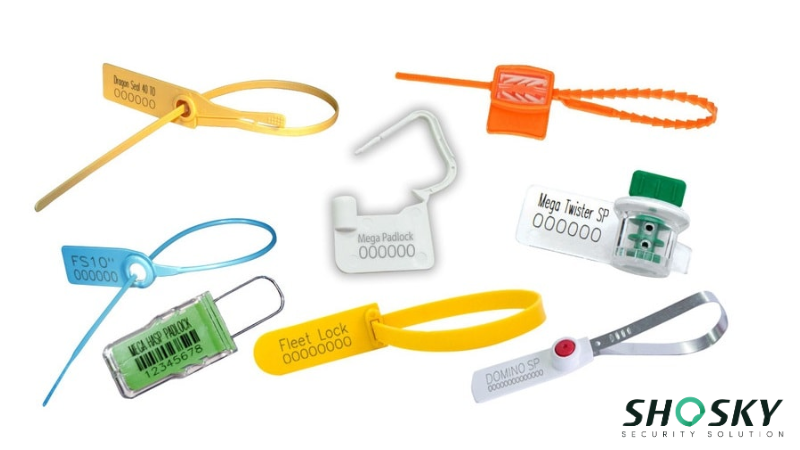
Security seals, also known as tamper-evident seals, are specialized tools designed to detect unauthorized access or tampering with goods during storage or transportation. These seals provide clear visual evidence if an item has been tampered with, making them an essential part of modern supply chains.
While security seals cannot physically prevent tampering, they act as a deterrent and provide a critical layer of assurance for companies and customers. Available in a variety of types, shapes, and sizes, security seals cater to different levels of security needs.
For example, cost-effective plastic seals may be suitable for local shipping of less expensive goods. In contrast, high-security metal seals are often used for international freight or high-value shipments where enhanced protection is required. Whether for local deliveries or global logistics, security seals play a vital role in maintaining the integrity of goods and building confidence across industries.
Types of Security Seals and Their Applications
Here is a detailed list of the most popular security seal types, ranging from the least secure to the most secure.
| Seal Type | Material | Tamper Evidence | Typical Applications | Removal Method |
|---|---|---|---|---|
| Adhesive Seals | Paper/Plastic with adhesive | Leaves residue or VOID message upon removal | Packaging boxes, electronics, retail products | Manual peeling |
| Plastic Seals | Polypropylene (PP) or High-Density Polyethylene (HDPE) | Breaks or shows signs of tampering when cut | Containers, bags, retail items | Cutting with scissors or snips |
| Metal Strap Seals | Tin-plated steel or stainless steel | Requires cutting to remove; shows clear tampering | Shipping containers, storage units | Bolt cutters |
| Metal Cable Seals | Galvanized or stainless steel cable | Frays or cannot be resealed once cut | High-security transport, freight, logistics | Industrial cable cutters |
| Padlock Seals | Plastic body with metal hasp | Breaks upon unauthorized opening | Utility meters, first aid kits, luggage | Manual breaking |
| Bolt Seals | Steel bolt with plastic coating | Requires bolt cutters; irreversible once sealed | International shipping, cargo containers | Heavy-duty bolt cutters |
| Electronic Seals (E-Seals) | Electronic components with RFID or GPS | Real-time alerts; logs tampering attempts | High-value shipments, sensitive cargo | Authorized electronic access |
1. Adhesive Security Seals
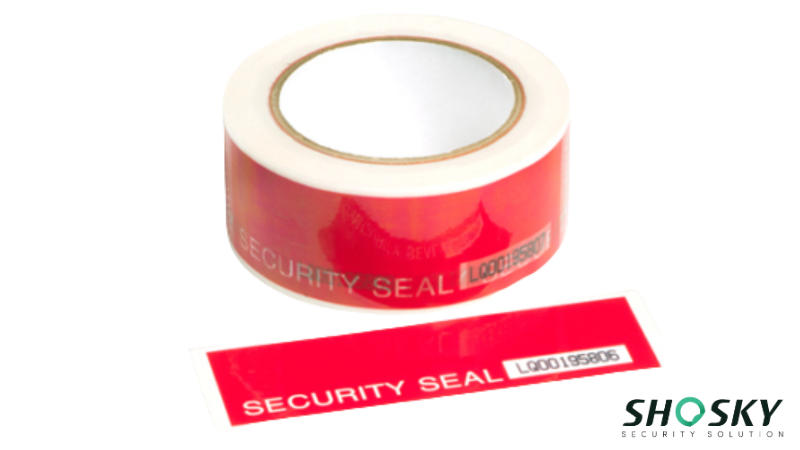
Adhesive seals are the most common and affordable type of security seal. They typically come in the form of a roll of tape or cut-out stickers. The surface of adhesive seals has some sort of warning printed on it, such as “Warranty Void if Opened” or “Do Not Remove”.
You will mostly see these types of security seals on cardboard boxes. Removing adhesive tapes leaves marks on the box indicating tampering. Online stores strategically place adhesive tape on their packages. So, if anyone tries to open the package before it reaches the customer, the tampering will be evident.
Adhesive seals can also take the form of a plastic security bag. These bags have an industrial-grade adhesive applicator on one end. Thus, the only way to open the bag is to tear or cut it from the side. Apple famously uses an adhesive security seal for its iPhone boxes.
Compared to other tamper-evident seals, adhesive seals are incredibly cost-effective and easy to use.
Advantages
- Easy to Apply
- Cost Effective
- Tamper Evident
- Customizable
Disadvantages
- Easy to Break
- Not suitable for Container Security
2. Plastic Security Seals
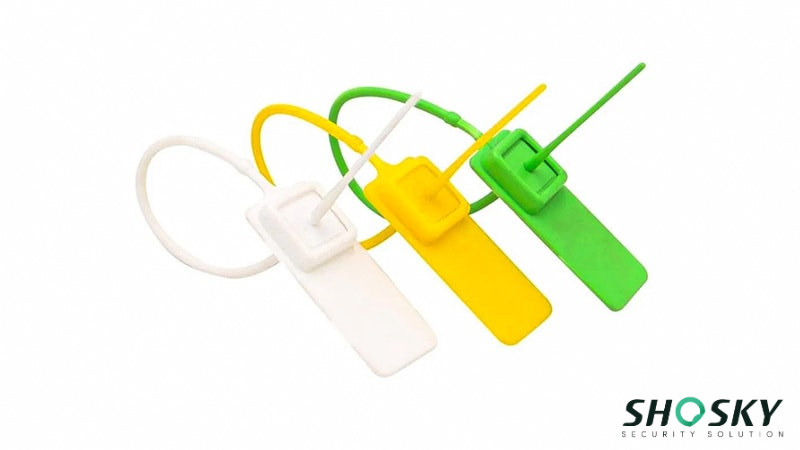
Plastic seals are a direct successor to adhesive seals. They are waterproof, weatherproof, and more durable. The most common type of plastic seal is a self-locking zip tie.
Most plastic seals are made from polypropylene (PP) or high-density polyethylene (HDPE). Polypropylene is lightweight and flexible and can be molded into complex shapes. In comparison, HDPE is tougher and can withstand low temperatures.
Plastic seals can be used for various purposes. The most common application is securing containers and boxes. Additionally, you can use plastic seals for retail products like clothes or bag handles.
As a general rule of thumb, sellers should customize the security seals with brand logos or serial numbers. Thus, if someone tampers with the product and tries to replace the seal, they will not be able to match the design.
Any seals that prevent entry into a container are often called barrier seals. A barrier seal is used as an extra level of security against tampering.
Advantages
- Easy to Use
- Tamper Evident
- Customizable
- Versatility
Disadvantages
- Non Recyclable
3. Metal Strap Security Seals
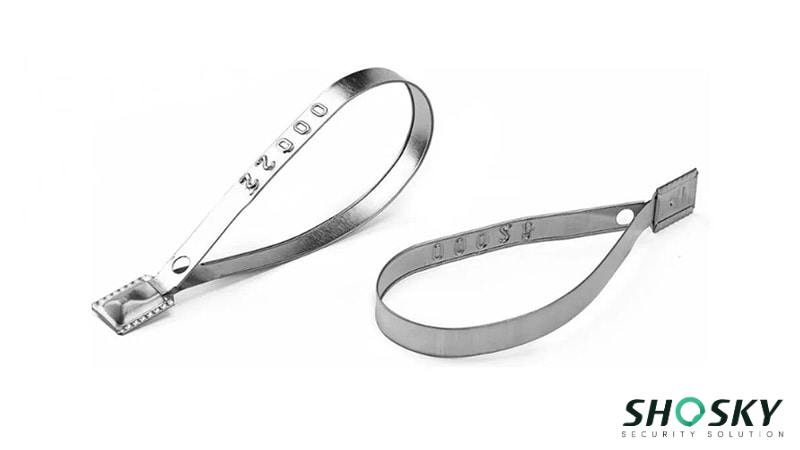
Metal seals have a similar design to their plastic brethren. Users can tighten the seal around a small box or thread it through a hole. However, unlike plastic seals, metal seals are primarily used to secure large stationary items.
Compared to plastic seals, metal ones are more difficult to cut and remove. Metal strap seals guarantee container safety. They are also much more difficult to counterfeit, ensuring peace of mind for customers.
Metal strap seals are difficult to customize and are often more expensive than plastic solutions. Customization is a necessity for security seals; otherwise, someone may remove the seal, tamper with goods, and replace it with a similar-looking counterfeit.
Common applications of metal security seals include securing large housings, single-use locks for storage units, and tamper identifiers for truck trailers.
Advantages
- Easy to Use
- Heat Resistance
- Wear & Tear Resistance
- Difficult to Counterfeit
Disadvantages
- Relatively Expensive
4. Metal Cable Security Seals
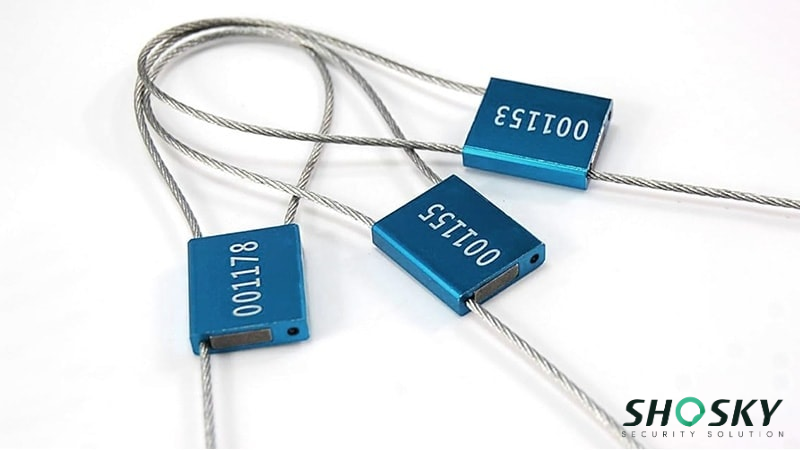
Cable seals are a hybrid between metal strap seals and plastic seals. They provide the versatility of a plastic seal while offering superior security. Household tools can cut through most security seals. However, you will need an industrial wire cutter to remove the metal cable seals.
Metal security seals are best suited for heavy-duty applications such as securing goods on trains, planes, and ships. The high tensile strength ensures the security seal will remain intact even after rough container handling.
Another big benefit of metal cables is their adjustable length. Strap seals are typically under a foot long, limiting their applications.
Advantages
- Easy to Use
- Heat Resistance
- Wear & Tear Resistance
- Difficult to Remove
- Versatile
Disadvantages
- Relatively Expensive
5. Padlock Seals
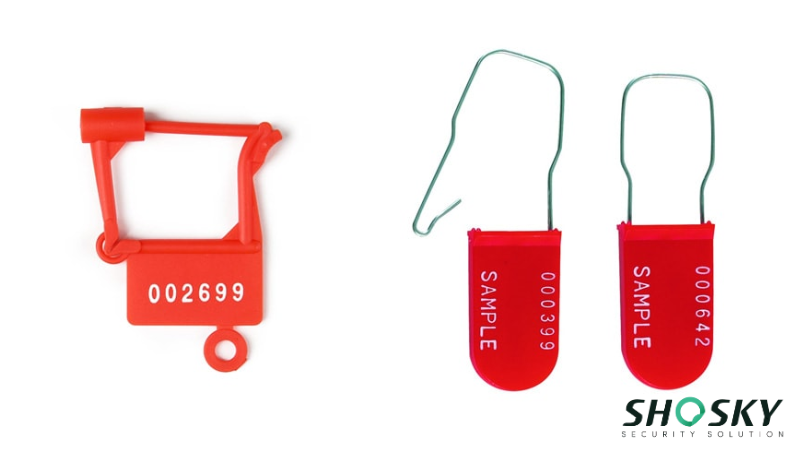
Padlock seals are plastic tags with a metal wire (sometimes plastic wire) locking system. They are designed for low-cost products and act as single-use security indicators.
Compared to other sealing solutions, padlock seals are very easy to remove. This is by design. Traditionally, metal padlocks are designed to keep unwanted individuals from opening a container. However, padlock seals are primarily used for tamper evidence.
To remove a padlock seal, users can twist the plastic tab to break the wire. The plastic tab has a serial number that indicates authenticity. Buyers should check the serial number before breaking the seal.
These seals are very versatile and are best suited for low-security applications such as utility meters, food crates, first aid boxes, or electronic devices.
Advantages
- Easy to Use
- Low-Cost
- Recyclable
- Versatile
Disadvantages
- Not Suitable for High-Security Applications
6. Bolt Seals
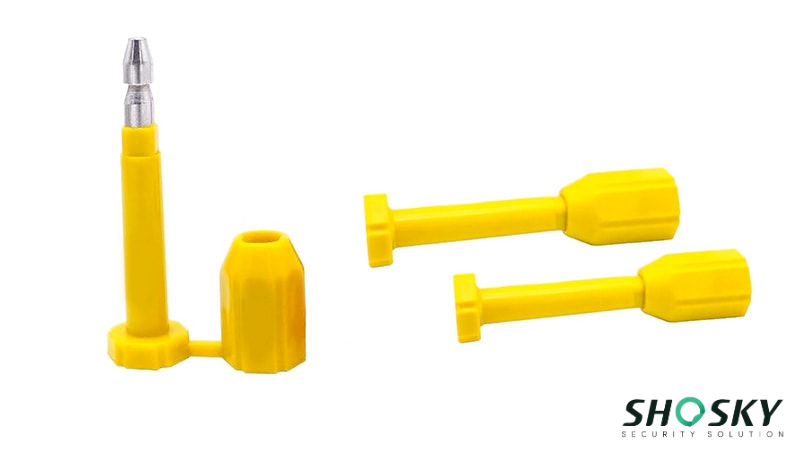
Bolt seals are the strongest type of container security that is commercially available. Most bolt seals follow the same design principle: a sturdy metal shaft encased in a plastic casing with a plastic cap. Users must firmly press the locking cap into the shaft after threading the metal shaft (bolt) through a hole. Keep pressing until you hear a clicking sound.
These types of seals are best used for international shipping applications. Comparing the design of bolt seals to metal cable seals yields some interesting results.
Firstly, cable seals can be removed with wire cutters, which are relatively easy to find. Additionally, bad actors can use metal files and other crude methods to remove a cable seal. However, bolt seals must be removed with industrial tools like bolt cutters or high-strength reciprocating saws.
Bolt seals are commonly used in the shipping industry to secure large containers. Local law enforcement may also use them to restrict access to crime scenes.
Low-quality bolt seals have a major flaw. They can be unlocked using a drill without destroying the bolts.
Today, manufacturers offer oval or hexagon-shaped bolt seals to prevent the drill attack.
Advantages
- Strong Security
- Recyclable
- Versatile
- Heat & Weather Resistant
Disadvantages
- Relatively Expensive
- Low-quality bolt Seals can be bypassed
7. Electronic Seals (E-Seals)
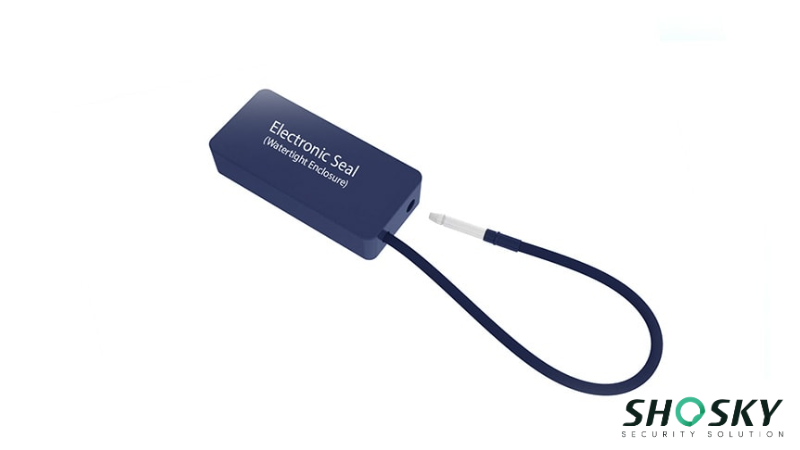
An electronic seal, commonly known as an E-seal, is a new type of reusable security device. These seals must be used in conjunction with another locking mechanism.
Sellers must secure their containers with a padlock or crossbar lock and use an E-seal for tamper evidence. In comparison, bolt seals guarantee security and provide tamper evidence. While other tamper-evident seals can be bypassed using creative solutions. Electronic seals are completely tamper-proof.
Electronic seals are permanently attached to the container or truck body and provide a random number every time the seal is activated. Any change in this number is an indication of tampering. Most e-seals have a digital log that detects software changes.
Potential bad actors can cut and replace a bolt seal with a similar-looking counterfeit. However, removing the electronic seal is nearly impossible and will leave clear tamper marks if attempted. Modern electronic seals use RFID chips for wireless communication and tamper alerts. Electronic seals are best suited to local shipping. They can be mounted onto company trucks that make regular deliveries. Ensuring maximum value is extracted from the reusability feature.
Advantages
- Strong Security
- Real-Time Alerts
- GPS Tracking
- Reusable
- Heat & Weather Resistant
Disadvantages
- Considerably Expensive
- Permanently Attached to Containers
How to Choose the Right Security Seal for Your Needs?
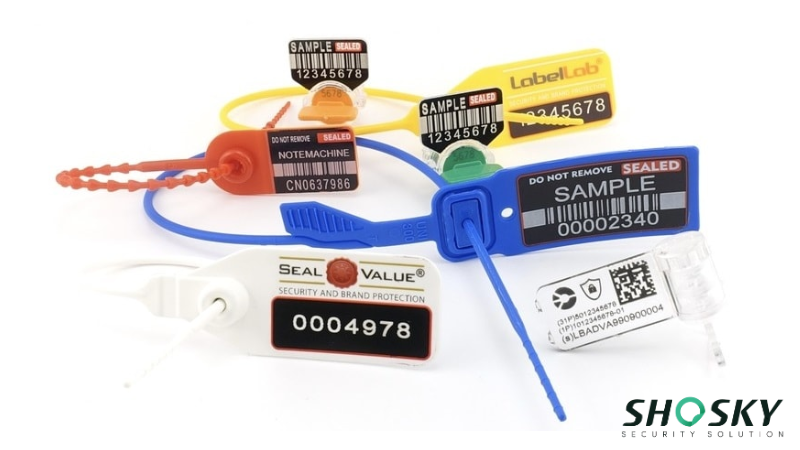
Selecting the right security seal requires assessing your specific needs and matching them with the available options. Follow these steps to get the right security solution for your business:
Step 1 – Determine your Application’s Security Level
Different applications require different levels of security. High-security seals are also significantly more expensive.
- Basic security involves simple stickers or tapes that seal a package but don’t prevent entry.
- Intermediate security involves using intrusion prevention barrier seals such as metal cable seals and zip ties (cable ties).
- Advanced security is designed for high-value products. These seals are significantly harder to remove and leave behind traces of tampering.
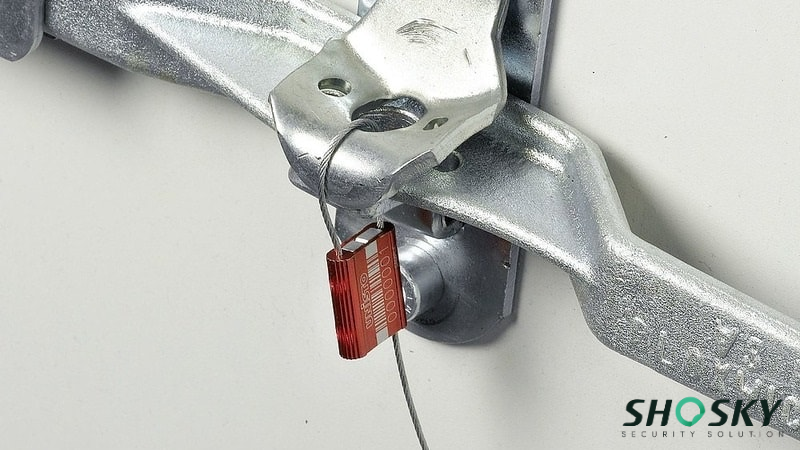
Step 2 – Choose an Appropriate Material
Material choice is directly related to cost and security level.
- Adhesive (paper) seals are the weakest and easiest to defeat. However, they leave behind glue residue as tampering evidence.
- Fixed-length Plastic seals provide better protection and are generally recommended for most applications.
- Metal cable and bolt seals are the strongest and very difficult to remove, making them ideal for long-distance shipping.
Step 3 – Check Industry Standards and Legal Compliance
Businesses should ensure compliance with the relevant industry regulations and standards as defined by the local government. A popular international shipping security standard is ISO 17712:2013. The standard lists durability and tamper-evidence requirements for mechanical container seals.
ISO security seals are more popular with clients as they add an extra level of reliability to the products.
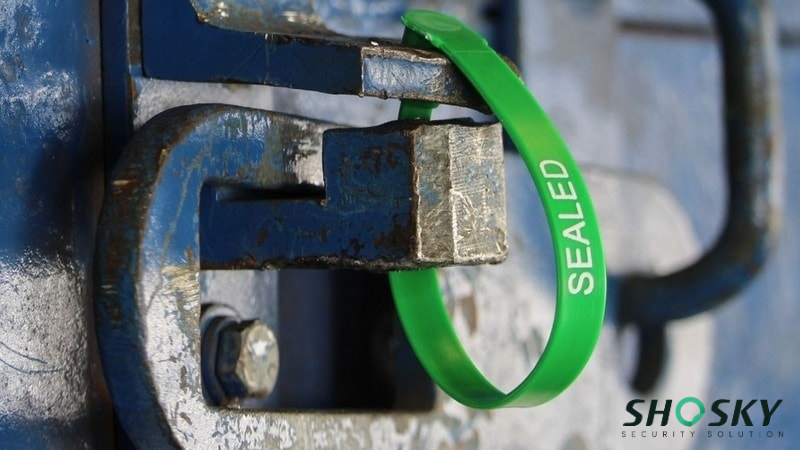
Step 4 – Cost Analysis
Finally, buyers must do a detailed cost analysis of the seals. High-security seals are excellent options, but completely unviable for low-value items. As a general rule, products under $25 and locally delivered are low-value items that don’t require expensive seals.
Another big cost factor is bulk orders. Most security seals are low-cost and high-volume items, so they are more affordable when ordered in bulk.
7 Industries that Use Security Seals
Security seals can be used for any number of applications. They verify a product’s integrity. Anything valuable will have a security seal on its container.
Here are some popular industries that regularly use security seals.
1. Logistics & Supply Chain
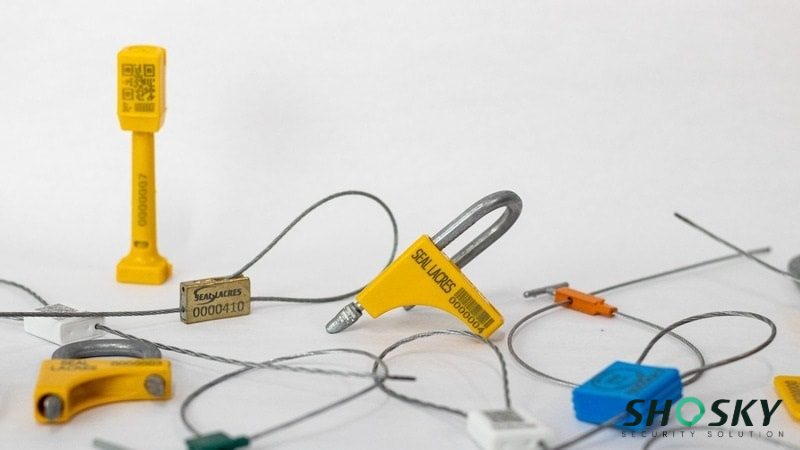
Any product shipped from one place to another should have a tamper-evident seal. These seals prevent theft and discourage unauthorized access during transport.
Security seals are commonly used on containers, truck doors, and crates.
2. Pharmaceutical Industry
The pharmaceutical industry needs to ensure that products remain safe and sterile by the time they reach the customers. Any potential tampering can seriously damage people’s health and well-being.
Medicine cartons and bottles have tamper-proof stickers that determine if the container has been previously opened.
3. Food & Beverage Industry
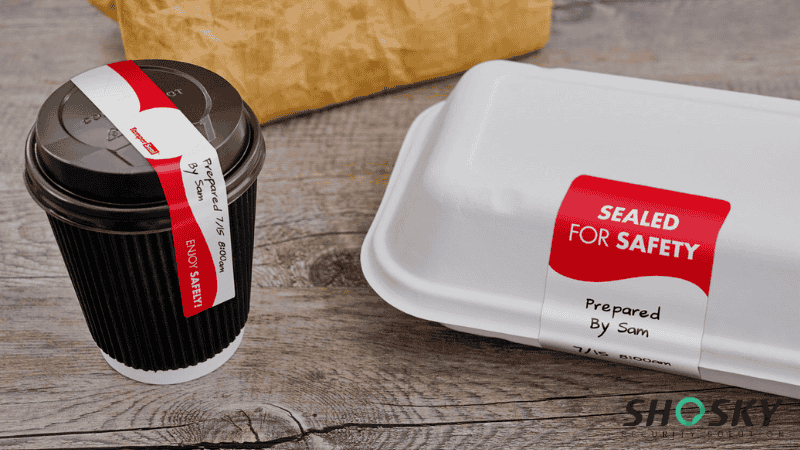
Similar to the pharmaceutical industry, the food industry must ensure that food reaches customers safely and hygienically.
Retail food items and ingredients use adhesive seals under bottle caps and jar lids to ensure safety. Similarly, the fast food industry wraps food items in paper or foil and adds a simple round sticker on the edge.
4. Banking & Financial Services
Banks deal with large amounts of cash and regularly handle sensitive client information. All financial and client documents must be enclosed in a bag with a tape seal.
Money is generally moved in large sacks with zip ties closing the mouth. These bags of cash are then loaded into trucks with an external electronic lock or padlock to ensure maximum security.
5. Healthcare and Laboratories
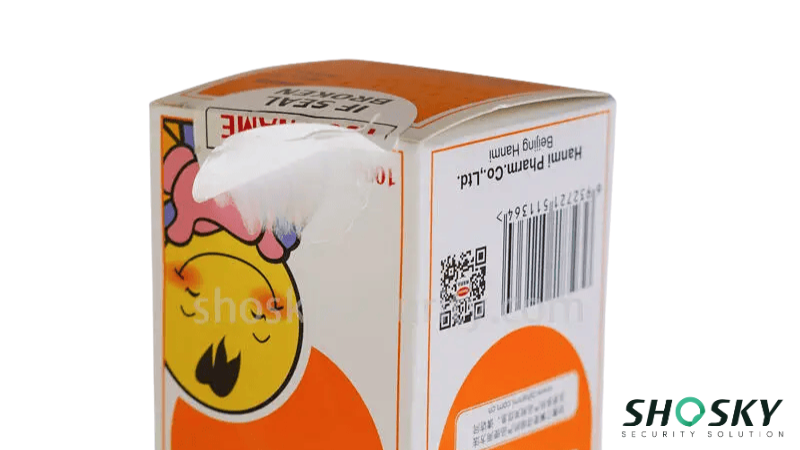
The healthcare industry generally uses security seals to safeguard confidential documents. Companies in the US are legally required to ensure the privacy of patients. Security seals like adhesive tapes ensure that the personal healthcare information of individuals is not seen by anyone other than the permitted parties.
Similarly, laboratories must ensure that samples are not contaminated during testing. Blood must be secured in a sealed bag or tube to ensure no particles enter the container.
6. E-commerce and Postal Services
Opening and tampering with another person’s mail is a federal crime in the United States. Security seals on parcels and envelopes prevent tampering and help enforce the law.
E-commerce platforms similarly seal their packages and courier bags to reduce potential scams. Tamper-evident bags are the most popular solution for e-commerce platforms.
7. Manufacturing Industry
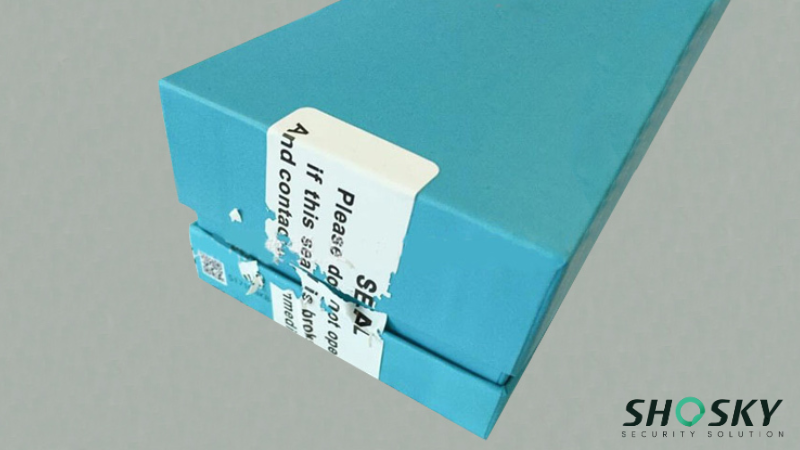
All manufacturing industries must ensure that products leaving the factory have a quality assurance and security seal. Once a product leaves the factory, it moves through multiple distribution points before reaching the end consumer.
Security seals provide customers with quality assurance, which helps build trust between the brand and consumers.
FAQs
Can security seals be reused?
Some types of security seals, such as electronic seals (e-seals), are designed to be reusable, while most others, like adhesive or metal seals, are for one-time use only.
How do I know if a seal has been tampered with?
Adhesive-based seals leave behind a sticky (glue) residue on the package. Ask the seller for a picture of the seal for plastic and metal security seals, and compare it to the package. Look for discrepancies in the serial number or color of the seal.
Are electronic seals more secure than traditional seals?
Yes, electronic seals provide constant monitoring and an access control log that provides evidence of tampering.
Conclusion
Nearly 12 billion tons of products are shipped worldwide every year, and ensuring the safety and integrity of these goods is essential to a healthy economy. By understanding the types of security seals, and investing in the right security seals, you can minimize losses due to theft or damage and enhance your overall operational efficiency.
Trust Shosky for Superior Security!
Shosky Security has been a trusted name in tamper-evident solutions for nearly 20 years. Our high-security seals are top-quality and budget-friendly. We also offer free samples to help you make buying decisions easier. Reach out now for a personalized quote!

